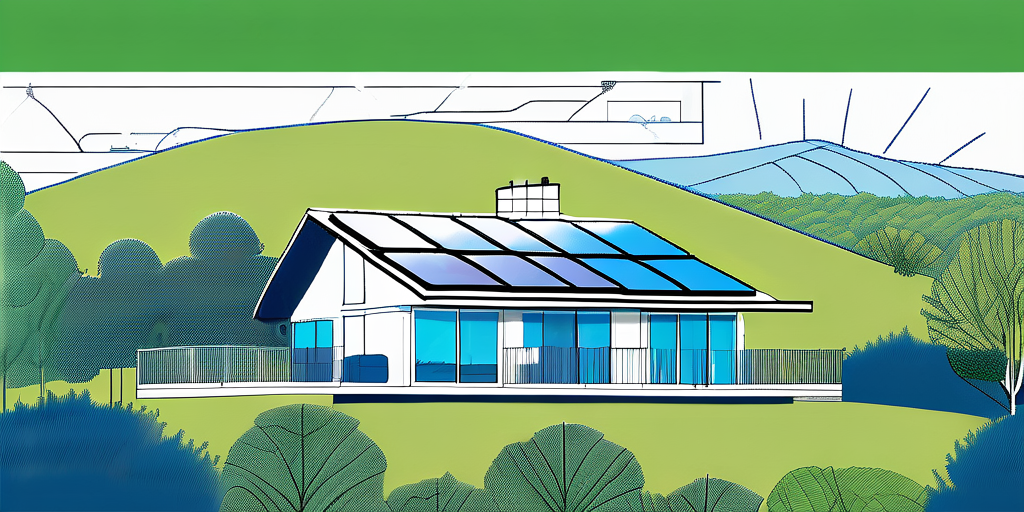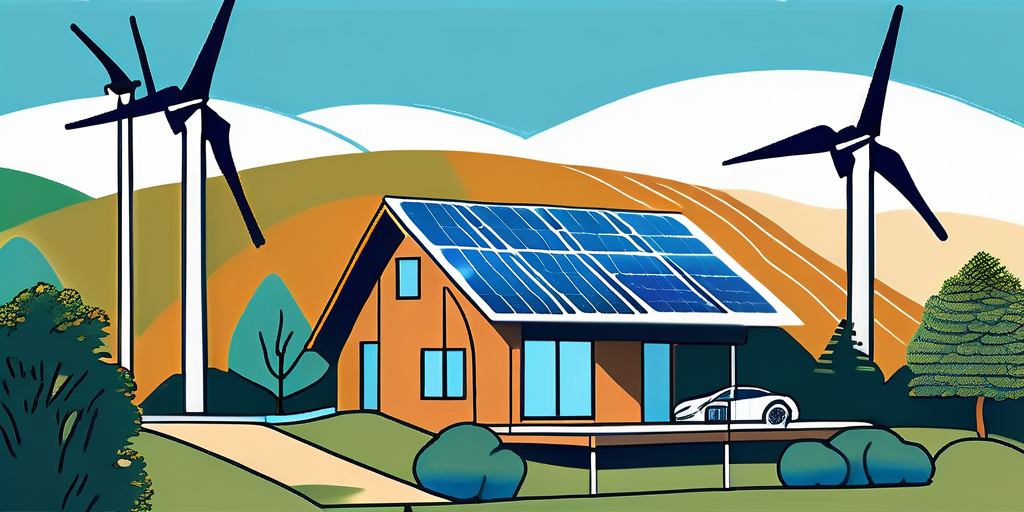
Building a sustainable home is an opportunity to contribute to the environment while creating a comfortable living space tailored to your lifestyle. At Tennessee National, a location known for its natural beauty and commitment to sustainability, creating a home that reflects these values is more than feasible—it's encouraged. This guide will walk you through the essentials of building a sustainable home from understanding sustainability, to planning, materials selection, incorporating renewable energy sources, and water conservation strategies.
Sustainability in home building refers to creating structures that are environmentally responsible and resource-efficient. This approach encompasses the entire lifecycle of a home, from design and construction to maintenance and eventual demolition. In Tennessee National, embracing sustainability means working harmoniously with the region's ecosystems.

By choosing sustainable practices, you not only reduce your carbon footprint but also contribute to your community's resilience. Sustainable housing promotes enhanced health, improved energy efficiency, and reduced waste while supporting the local environment. Additionally, the use of sustainable materials, such as reclaimed wood or recycled steel, not only minimizes the depletion of natural resources but also often adds unique character and charm to the home. This commitment to sustainability can foster a sense of pride among homeowners, as they play an active role in preserving the environment for future generations.
The importance of sustainable housing cannot be overstated. Not only does it encourage responsible use of resources, but it also fosters a healthier living environment. In Tennessee National, where nature is abundant, creating homes that respect natural landscapes is essential. Sustainable housing practices can also enhance biodiversity by incorporating native plants into landscaping, which supports local wildlife and helps maintain the ecological balance.
Moreover, sustainable homes tend to be cost-effective over time. With energy-efficient designs and materials, they often result in lower utility bills, making them financially beneficial for homeowners. Sustainability goes hand-in-hand with durability; homes built with eco-friendly practices are more likely to last longer and require less maintenance. Furthermore, as the demand for sustainable living grows, properties that incorporate these features may see an increase in market value, making them a wise investment for the future.
A sustainable home should incorporate specific key features that emphasize energy efficiency and environmental stewardship. Among these features are:
When thoughtfully integrated, these features create a habitat that is not only visually appealing but also innovative and functional. Additionally, the incorporation of rainwater harvesting systems can further enhance sustainability by reducing reliance on municipal water sources. Homeowners can use collected rainwater for irrigation or even for non-potable household uses, thereby conserving precious water resources. Another vital aspect is the use of sustainable building materials, such as bamboo flooring or low-VOC paints, which contribute to healthier indoor air quality and reduce harmful emissions. By prioritizing these elements, builders and homeowners alike can create spaces that are not only eco-friendly but also conducive to a high quality of life.
With a clear understanding of sustainability in home building, the next step is planning your sustainable home. Considering Tennessee National's unique geographical attributes will enhance your building experience and outcome.

Location is key when building a sustainable home. In Tennessee National, take time to evaluate various aspects of the land: sunlight exposure, wind patterns, and proximity to natural resources. Select a plot where the natural environment can be respected and incorporated into your home design.
Furthermore, consider the community aspect. Building near local amenities like grocery stores, parks, and schools can foster a supportive community and reduce transportation-related emissions. Understanding the wildlife and vegetation in the area will help in creating harmony between your home and its surroundings. Engaging with local conservation groups can provide valuable insights into the native species and ecosystems, ensuring that your home not only coexists with nature but also contributes positively to the local environment.
Additionally, think about the long-term implications of your location choice. Areas prone to flooding or other natural disasters may require additional planning and resources to build sustainably. By researching historical weather patterns and environmental changes, you can make informed decisions that will protect your investment and ensure the longevity of your home.
Once you have chosen the right location, the design phase becomes pivotal. Energy-efficient designs focus on optimizing resource use while maximizing comfort. This can include strategically placing windows to capture natural light, using thermal mass materials that retain heat, and ensuring proper airflow throughout the house.
Collaboration with architects or builders who specialize in sustainable design can significantly enhance this aspect. They can offer insights on environmentally friendly design ideas that fit the Tennessee National landscape while adhering to sustainability goals. For instance, incorporating green roofs or solar panels can significantly reduce energy consumption and promote self-sufficiency. Moreover, utilizing local materials not only supports regional economies but also minimizes the carbon footprint associated with transportation.
Incorporating smart home technology can further boost energy efficiency. Systems that monitor energy usage and adjust heating and cooling accordingly can lead to substantial savings over time. Additionally, consider integrating rainwater harvesting systems or greywater recycling to reduce water usage, which is especially beneficial in areas that may experience drought conditions. These innovative solutions not only enhance sustainability but also create a more resilient and adaptable living environment.
The materials you choose will have a substantial impact on the sustainability of your home. Selecting the right materials is crucial for enhancing energy efficiency and lowering your home's environmental impact.
Opt for eco-friendly building materials that reduce environmental impact during production and installation. Green building materials include recycled steel, reclaimed wood, bamboo, and cork flooring. These alternatives not only help to conserve natural resources but also offer unique aesthetics.
Additionally, consider using low-VOC (volatile organic compounds) paints and finishes. Such options are healthier for indoor air quality, minimizing harmful chemicals in your living space. Furthermore, integrating natural insulation materials like sheep's wool or cellulose can significantly improve your home's energy efficiency, keeping it warm in the winter and cool in the summer while reducing the need for artificial heating and cooling systems.
One effective way to support sustainability is by sourcing locally available materials. This reduces transportation emissions and supports the local economy. Investigate local suppliers for bricks, stones, and timber that align with your sustainable building goals.
Utilizing local materials also allows your home to blend seamlessly into the natural environment of Tennessee National, enhancing its overall aesthetic appeal. Moreover, local materials often come with a lower carbon footprint and can be more durable, as they are often better suited to the local climate. By choosing materials that are native to your area, you not only honor the local landscape but also create a home that is resilient and harmonious with its surroundings. Engaging with local artisans and craftsmen can also add a personalized touch to your home, ensuring that it reflects the unique character of the region.
In today's world, renewable energy sources are fundamental to achieving sustainable living. They provide clean energy solutions that can significantly reduce dependency on non-renewable resources. As climate change continues to pose a serious threat to our planet, the transition to renewable energy becomes not just an option but a necessity for future generations.

Solar power is a leading choice for homeowners looking to implement renewable energy. With ample sunlight available in Tennessee National, installing solar panels can offset a significant portion of your electricity consumption. This investment not only benefits the environment but also provides long-term financial savings. Moreover, advancements in solar technology have made panels more efficient and aesthetically pleasing, allowing homeowners to blend them seamlessly into their roofs without compromising on style.
Consider working with qualified solar installers who can ensure optimal placement and energy efficiency in your solar power system. Many states, including Tennessee, offer incentives for solar energy installations, making it an even more attractive option. Additionally, community solar programs are gaining traction, allowing those who may not have suitable roofs to participate in solar energy generation through shared solar farms, further promoting energy equity and accessibility.
While solar power takes center stage, wind energy should not be overlooked. For those living in areas with consistent wind patterns, small wind turbines can be a viable option to generate clean energy. Wind energy systems can work independently or in conjunction with solar power to create a hybrid energy solution tailored to your home's needs. These systems not only contribute to reducing your carbon footprint but also enhance energy resilience, especially in regions prone to power outages.
It's essential to conduct an assessment to determine if your property is suitable for installing wind systems, including wind speed and zoning regulations. Engaging a professional can help with this evaluation. Furthermore, many local governments are beginning to recognize the potential of wind energy and are streamlining the permitting process, making it easier for homeowners to invest in this renewable resource. By combining both solar and wind energy, homeowners can maximize their energy independence and contribute to a more sustainable future.
Water conservation is a critical aspect of sustainable living. By implementing effective strategies in your home, you can significantly reduce water usage while preserving this precious resource.
One of the most effective water conservation techniques is rainwater harvesting. This system collects and stores rainwater from rooftops for later use, such as irrigation or even flushing toilets. In Tennessee National, where rain is abundant, this strategy can greatly reduce your reliance on municipal water sources.
Integrating a rainwater harvesting system involves installing gutters and downspouts connected to a storage tank. Ensure you comply with local regulations regarding rainwater collection for efficient setup. Additionally, consider using filtration systems to purify the collected water, making it suitable for various household applications. By creating a well-designed rainwater harvesting system, you not only contribute to water conservation but also create a sustainable ecosystem that can support local flora and fauna.
In addition to rainwater harvesting, consider using efficient plumbing fixtures and appliances that conserve water. Low-flow toilets, showerheads, and faucets can significantly reduce water waste without sacrificing performance.
Energy-efficient appliances, such as dishwashers and washing machines, additionally minimize water usage while promoting lower energy consumption, contributing to your home's overall sustainability. Furthermore, regular maintenance of these fixtures is essential to ensure they operate at peak efficiency. Simple actions, like checking for leaks or replacing worn-out washers, can prevent unnecessary water loss and extend the lifespan of your plumbing systems. By making these small but impactful changes, you can create a more water-efficient home that aligns with your commitment to environmental stewardship.
In conclusion, embarking on the journey towards building a sustainable home in Tennessee National is an enriching experience that benefits both you and the environment. By understanding the principles of sustainability, carefully planning your home, selecting appropriate materials, integrating renewable energy sources, and implementing water conservation methods, you can create a harmonious living space that aligns with nature's beauty. Embrace this opportunity to build a home that reflects your values while creating a positive impact on the planet.